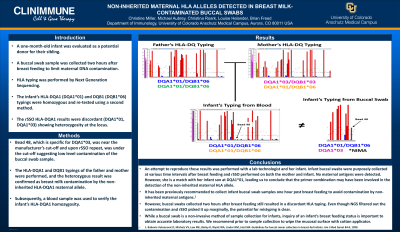Back

NON-INHERITED MATERNAL HLA ALLELES DETECTED IN BREAST MILK-CONTAMINATED BUCCAL SWABS
(P314) Non-inherited maternal HLA alleles detected in breast milk-contaminated buccal swabs
Location: Platinum Ballroom

Poster Presenter(s)
Body: An infant was evaluated as a potential donor for their sibling. A buccal swab sample was collected two hours after breast feeding to limit maternal DNA contamination. HLA typing was performed by Next Generation Sequencing. The infant’s HLA-DQA1 (DQA1*01) and DQB1 (DQB1*06) typings were homozygous and re-tested using a second method. The rSSO HLA-DQA1 results were discordant (DQA1*01, DQA1*03) showing heterozygosity at the locus. Bead 48, which is specific for DQA1*03, was near the manufacturer’s cut-off and upon rSSO repeat, was under the cut-off suggesting low level contamination of the buccal swab sample. The HLA-DQA1 and DQB1 typings of the father and mother were performed, and the heterozygous result was confirmed as breast milk contamination by the non-inherited HLA-DQA1 maternal allele. Subsequently, a blood sample was used to verify the infant’s HLA-DQA1 homozygosity.
Conclusion: It has been previously recommended to collect infant buccal swab samples one hour post breast feeding to avoid contamination by non-inherited maternal antigens.1 However, buccal swabs collected two hours after breast feeding still resulted in a discordant HLA typing. Even though NGS filtered out the contamination and rSSO picked it up marginally, the potential for mistyping is clear. While a buccal swab is a non-invasive method of sample collection for infants, inquiry of an infant’s breast feeding status is important to obtain accurate laboratory results. We recommend prior to sample collection to wipe the mucosal surface with cotton applicator.
Conclusion: It has been previously recommended to collect infant buccal swab samples one hour post breast feeding to avoid contamination by non-inherited maternal antigens.1 However, buccal swabs collected two hours after breast feeding still resulted in a discordant HLA typing. Even though NGS filtered out the contamination and rSSO picked it up marginally, the potential for mistyping is clear. While a buccal swab is a non-invasive method of sample collection for infants, inquiry of an infant’s breast feeding status is important to obtain accurate laboratory results. We recommend prior to sample collection to wipe the mucosal surface with cotton applicator.

